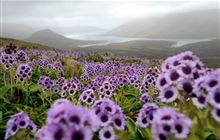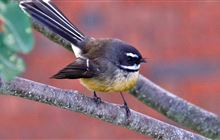Animals of New Zealand's subantarctic islands
Introduction
New Zealand's subantarctic islands are home to a range of birds and marine mammals.Land and freshwater birds
Land and freshwater birds on New Zealand's subantarctic islands are surprisingly numerous, diverse and in some cases very rare on this haven away from the mainland. No fewer than 15 species are found nowhere else on earth.
Some species of New Zealand birds have survived on our subantarctic islands long after introduced predators wiped them out on the mainland.
For example the New Zealand snipe, extinct for around 1,000 years on the mainland, thrive on The Snares, Antipodes Island and on some islands that have remained free of cats and pigs in the Auckland Island group. They also survived on Jaquemart, a small islet in the Campbell Island group, and are rapidly re-establishing on Campbell Island itself, now that rats have been removed.
Over the last 125 years many species of birds have been introduced to mainland New Zealand by humans. At least 10 species have successfully colonised one or more subantarctic island groups including the redpoll, dunnock, blackbird and mallard.
The small teal of Auckland and Campbell islands are of great interest as they have independently evolved into flightless forms.
While flightless birds not particularly prevalent in New Zealand's subantarctic, several other forms, including the three snipe, the Auckland Island rail and The Snares fernbird, have reduced powers of flight.
The characteristic tameness of these subantartic birds, combined with their ground-nesting habit and unwillingness to fly, has made them vulnerable to introduced mammalian predators. This problem has been accentuated in some cases by introduced herbivores. Since the mid 1800s, these herbivores drastically altered the vegetation on some islands, reducing cover for many species.
The fact that some islands in each group have remained free of introduced predators has been vital for the survival of most endemic land and freshwater birds.
Seabirds
New Zealand's subantarctic islands would be a strong contender for the title of 'seabird capital of the world' with more than 40 seabird species(at least 11% of all the world's seabirds) breeding in the region, and over 120 species having been observed at the islands or in the surrounding ocean.
Each year the urge to breed brings millions of seabirds to the islands. Because land masses are few and far between in the Southern Ocean, the subantarctic islands are vital breeding grounds for many of these birds. Most of them would not have touched land since the previous breeding season and the younger birds may not have been on land since they fledged up to seven years before.
The seabirds that breed on these islands range in size from delicate storm petrels which will easily fit in your hand, to the great albatrosses with wing-spans over 3.3 m.
Albatross
The albatross and their small cousins the mollymawks are the most obvious and easily recognised. Ten of the world's albatross species breed in the region, six of them nowhere else.
The six are three great albatrosses (Gibsons, Antipodean and southern royal) and three albatrosses in the mollymawk group (Campbell, Salvins and white-capped), although one white-capped nest has been found at the Chatham Islands.
Petrels, shearwaters, fulmars and prions
Among the world-wide family of petrels, shearwaters, fulmars and prions, 21 species or 30% breed on New Zealand's subantarctic islands.
Sooty shearwaters, or tītī, are the most numerous seabird in southern New Zealand waters. A vast population (millions of pairs) nest on The Snares. Having completed a 15,000 km journey into the north Pacific these birds return with uncanny accuracy to the same burrow each year.
Although dependant on land during the breeding season, all of these birds rely on the sea for their food. When feeding chicks it is not unusual for adults to spend more than five days out at sea harvesting the food-rich waters which surround the islands.
Penguins
Ten species of penguin have been recorded on New Zealand’s subantarctic islands. Four of these breed there. They include the yellow-eyed penguin; and three species of crested penguin, including the Snares crested and erect crested penguins who are both endemic to the region.
Yellow-eyed penguin breed at sites on Auckland and Campbell islands.
Shags, gulls, skuas and terns
Each type of marine shag (cormorant) found in the area is endemic to its own island group, namely the Aucklands, Campbell and the Bounties. The Bounty Island shag is the rarest of all cormorants with a population of fewer than 600 individuals.
Cormorants feed at sea but return to land each night to roost. They are present on the islands throughout the year.
Gulls, terns and skuas are present on all the islands of New Zealand's subantarctic, except the for the Bounties, where there are no skua. Species composition does vary from island group to island group.
The southern skua is particularly widespread. On many of the islands the skua is the main predator, killing large numbers of petrels and taking penguin eggs and chicks.
Southern black-backed gulls are also widespread and while the red-billed gulls are absent from the Bounty and Antipodes islands they are present on the Snares, Aucklands and Campbell island groups.
Dainty Antarctic terns breed in small numbers on the island groups, and the larger white fronted tern is also found on the Auckland Islands.
New Zealand sea lion
The New Zealand sea lion population is centred on the Auckland Islands, where two of the major breeding sites are located (on Dundas and Enderby Islands). The other breeding site is in the Campbell Island group.
Sea lion numbers were greatly reduced during the sealing era of the early 19th century, when they were killed both for their skins and their oil.
Fur seals
Once extremely abundant on the subantarctic islands New Zealand fur seals were almost wiped out by sealers in the early 19th century. Numbers are increasing around the islands and they are often seen on the more exposed rocky coasts of the islands.
It is estimated the population is currently more than 50,000 but an accurate count is nearly impossible at most sites.
Southern elephant seal
Southern elephant seals are regular visitors to New Zealand's subantarctic islands. Once common throughout the area, southern elephant seals were heavily exploited for their oil until the turn of the century.
While the main breeding centre is at Macquarie Island, where there are over 11,000 individuals during the breeding season, in New Zealand the main breeding colony is on the Antipodes islands, with the occasional pup born on Campbell Island. Breeding takes place from September to October and mating follows about three weeks after pups are born.
Leopard seal
Leopard seals breed around Antarctica but frequently visit the subantarctic islands during the winter .
Whales
New Zealand, and its subantarctic islands, straddle the north-south migratory routes of many of the whales found in the South Pacific Ocean.
The southern right whale is the most significant whale species in the area. Port Ross in the Auckland Islands, is the main New Zealand breeding ground for the southern right whale.


